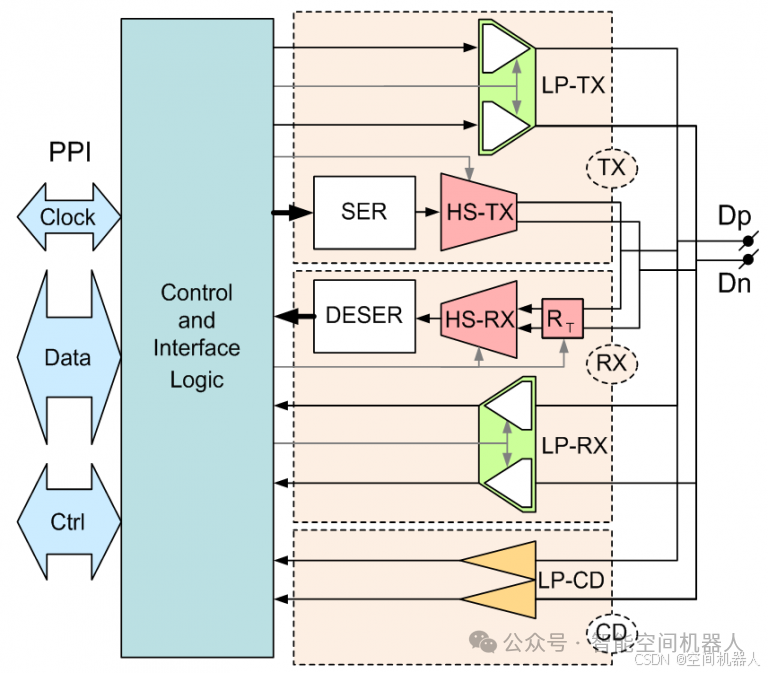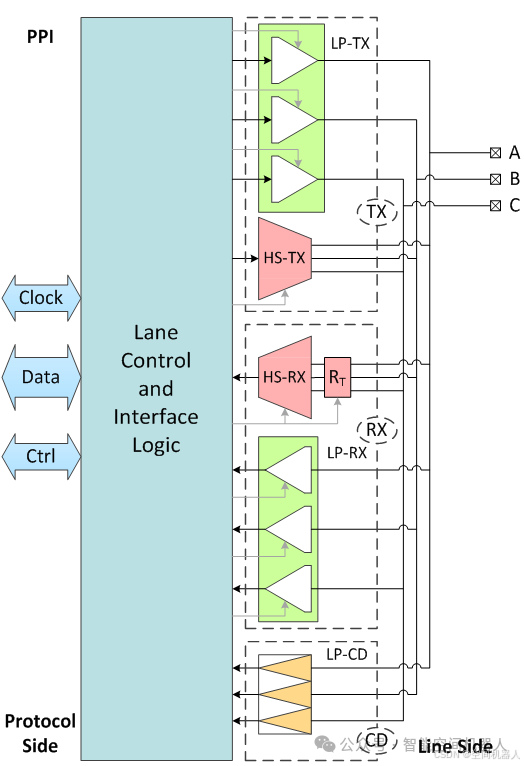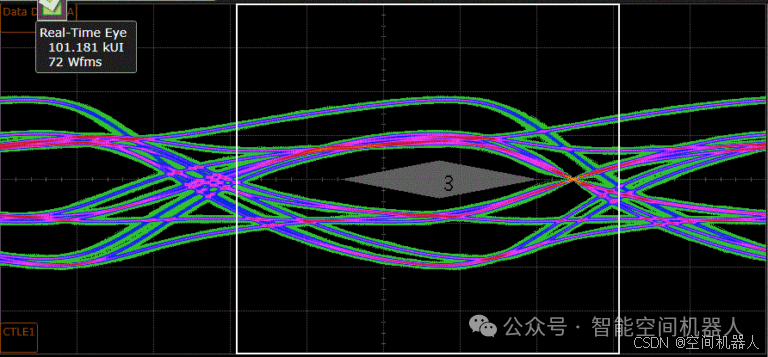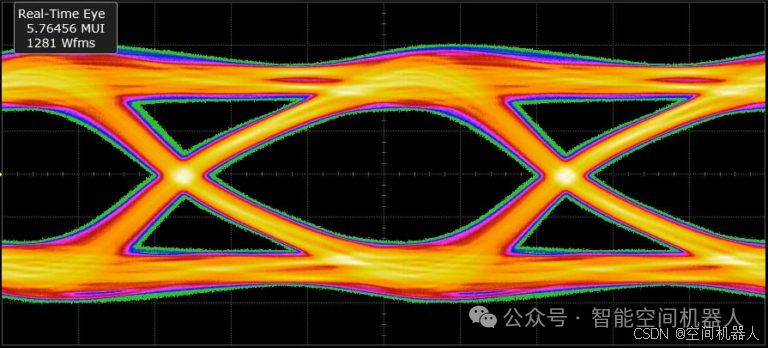
Analysis of MIPI C-PHY/D-PHY Combination Technology 🚀
MIPI C-PHY and D-PHY are two PHY physical layer interface technologies used for high-speed serial data transmission, widely applied in cameras (CSI-2) and display interfaces (DSI). The C-PHY/D-PHY combination (CPHY-DPHY) can simultaneously support both standards, providing higher bandwidth, lower power consumption, and reduced system overhead.
🌟 Main Differences Between MIPI C-PHY and D-PHY
| Feature | MIPI D-PHY | MIPI C-PHY |
|---|---|---|
| Signal Lines | 1 clock channel + 4 data channels | 3 data channels (3 lines per channel) |
| Encoding Method | NRZ (Non-Return-to-Zero) | Three-phase symbol encoding |
| Data Rate | 80 Mbps ~ 1.5 Gbps (standard mode) up to 4.5 Gbps (de-skew calibration) |
Equivalent data rate 182.8 Mbps ~ 10.26 Gbps (per channel) |
| Signal Voltage | Low swing (high-speed mode) High swing (low-power mode) |
Low swing (high-speed mode) |
| Low Power Mode | Supports LP mode (10 Mbps) | Supports LP mode (10 Mbps) |
| Application Scenarios | Traditional cameras, display panels, automotive electronics | High-resolution cameras, 8K video transmission, high-speed AI vision systems |

🔍 Features of C-PHY/D-PHY Combination
The advantage of the C-PHY/D-PHY combination is that it can be compatible with both standards and dynamically switch modes based on application requirements. Its main features include:
✅ Dual-Mode Support for C-PHY/D-PHY
- Supports MIPI D-PHY v2.5 (backward compatible with v2.1, v1.2, and v1.1)
- Supports MIPI C-PHY v2.0 (backward compatible with v1.1 and v1.2)
- Provides 4 data channels in D-PHY mode
- Provides 3 data channels (3 lines per channel) in C-PHY mode
✅ High-Speed and Low-Power Modes
- D-PHY High-Speed Mode:
- 80 Mbps ~ 1.5 Gbps (standard)
- Up to 4.5 Gbps (de-skew calibration)
- C-PHY High-Speed Mode:
- 80 Msps ~ 4.5 Gsps
- Equivalent data rate 182.8 Mbps ~ 10.26 Gbps
- Low Power Mode:
- LP rate 10 Mbps
- Supports HS-TX half-swing mode to reduce power consumption
- Supports HS-RX no termination mode to improve compatibility
✅ Silicon Validation and Testability
- Supports loopback testability (BIST)
- Optional resistor termination calibrator
- De-skew calibration to improve data integrity
- Supports cost-effective large-scale manufacturing testing
 C-PHY operating at 4.5Gsps
C-PHY operating at 4.5Gsps
— D-PHY operating at 4.5Gbps
D-PHY operating at 4.5Gbps
🎯 Typical Applications of C-PHY/D-PHY
📸 MIPI CSI-2 Cameras
- Smartphones, autonomous driving, industrial cameras
- Achieving 4K/8K video transmission through C-PHY high bandwidth
- Low power mode supports standby and control signal transmission
📺 MIPI DSI Display Interface
- High-resolution OLED / LCD screens
- Smartphones, tablets, VR/AR display devices
- D-PHY is suitable for traditional display panels
- C-PHY is suitable for 8K ultra-high-definition displays
🚗 In-Vehicle Vision Systems
- ADAS (Advanced Driver Assistance Systems)
- Surround view cameras, rearview images
- C-PHY provides higher bandwidth to meet high-resolution image requirements
🛠️ C-PHY/D-PHY Python Data Simulation
To better understand the data transmission methods of C-PHY and D-PHY, the following Python code simulates C-PHY three-phase symbol encoding and D-PHY NRZ transmission.
import numpy as np
class MIPI_PHY:
def __init__(self, mode="D-PHY"):
self.mode = mode
def encode_dphy(self, data):
"""D-PHY uses NRZ encoding"""
encoded = "".join(format(byte, '08b') for byte in data)
print(f"🔷 D-PHY encoded data: {encoded}")
return encoded
def encode_cphy(self, data):
"""C-PHY three-phase symbol encoding (simple simulation)"""
symbol_map = {"000": "0", "001": "1", "010": "2", "011": "3",
"100": "4", "101": "5", "110": "6", "111": "7"}
encoded = "".join(symbol_map[format(byte, '03b')] for byte in data)
print(f"🔶 C-PHY encoded data: {encoded}")
return encoded
def transmit(self, data):
"""Transmit data"""
if self.mode == "D-PHY":
return self.encode_dphy(data)
elif self.mode == "C-PHY":
return self.encode_cphy(data)
# Generate random data
data = np.random.randint(0, 8, 8) # 8 pieces of 3-bit data
# Create MIPI PHY instance
phy = MIPI_PHY(mode="C-PHY")
# Transmit data
phy.transmit(data)
🔚 Conclusion
The MIPI C-PHY/D-PHY combination provides a flexible high-speed data transmission solution suitable for cameras, displays, automotive electronics and other high-bandwidth application scenarios.
- D-PHY is suitable for traditional MIPI DSI / CSI-2 devices, providing up to 4.5 Gbps rates
- C-PHY uses three-phase symbol encoding, providing higher equivalent data bandwidth (10.26 Gbps)
- Both can be reused on the same PHY structure, improving compatibility and reducing area overhead
In the future, with the development of smart vision, autonomous driving, AR/VR and other technologies, MIPI C-PHY/D-PHY will play an increasingly important role in high-speed data transmission! 🚀